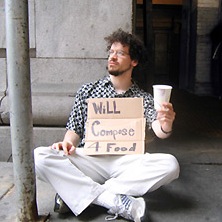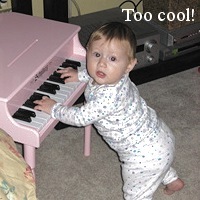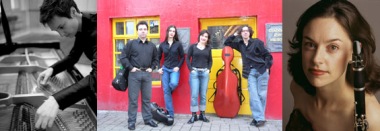We need somebody to do a pre-concert interview with Terry Riley and maybe review his Bang on a Can happening at Le Poisson Rouge on November 8. Free tickets, of course. Hands?
 For those of you who, like me, have been wondering whatever happened to the once ubiquitous S21 familiar Ian Moss but have been too forgetful to ask around, we have news of two upcoming concerts and an explanation for his absence.
For those of you who, like me, have been wondering whatever happened to the once ubiquitous S21 familiar Ian Moss but have been too forgetful to ask around, we have news of two upcoming concerts and an explanation for his absence.
The first concert is a surprise (well, I guess we gave it away) reunion show on Thursday night with Ian’s jazz/metal/awesomeness band, Capital M which will be playing a set of 100% improvised music at the old Knitting Factory Tap Bar, one of the legendary venues for experimental music in New York and, alas, another historic spot getting ready to flee the island for Brooklyn soon due to enormous pressures in the local real estate market. This will be one of last shows in the Tribeca location.
Thursday, October 30
Capital M @
Knitting Factory Tap Bar
74 Leonard Street
8pm (7:30 doors)
Then on Saturday, November 22, C4, the choral collective that Ian co-founded will present a concert called “Brazen Guns and Gentle Doves” at St. Joseph’s Church on the Upper East Side.
Saturday, November 22
C4: The Choral Composer/Conductor Collective
St. Joseph’s Church
404 E 87th Street
8pm
For more updates on the adventures of Ian, check out his blog, Createquity. p.s. He’s been going to business school, of all unlikely things.
 Kronos Plays Holmgreen: I don’t approve of recordings in which people talk while I’m trying to listen to music but I’m making an exception for the Kronos Quartet’s new Dacapo recording of works by the Danish composer Pelle Gudmundsen-Holmgreen. Kronos Plays Holmgreen is the culmination of 20 years of collaboration between Holmgreen and the Kronos Quartet, and includes his Concerto Grosso for string quartet and orchestra (1990; rev. 1995); Moving Still, written for Hans Christian Andersen’s bicentenary in 2005 and featuring Paul Hillier; and Last Ground, his Ninth String Quartet, written in 2006 and dedicated to the Kronos Quartet. Moving Still is the piece with the talking: in part one, Paul Hiller reads Hans Christian Andersen’s prophetic text In a Thousand Years, a Jules Verne-like fantasy predicting that Americans will one day be able to fly over the Atlantic and “see Europe in a week.” The text for part two comes from Andersen’s patriotic poem “Danmark er jeg født” (In Denmark I Was Born). If you don’t like talking, you can simply skip those cuts like I do. Holmgreen is a brilliant jokester, a kind of musical Samuel Beckett, drawing from Baroque music, Pygmy music, jazz, plainchant, the sounds of everyday life, and sheer noise to create music that is both absurd and sublime. The closest American counterpart I can think of is Sebastian Currier.
Kronos Plays Holmgreen: I don’t approve of recordings in which people talk while I’m trying to listen to music but I’m making an exception for the Kronos Quartet’s new Dacapo recording of works by the Danish composer Pelle Gudmundsen-Holmgreen. Kronos Plays Holmgreen is the culmination of 20 years of collaboration between Holmgreen and the Kronos Quartet, and includes his Concerto Grosso for string quartet and orchestra (1990; rev. 1995); Moving Still, written for Hans Christian Andersen’s bicentenary in 2005 and featuring Paul Hillier; and Last Ground, his Ninth String Quartet, written in 2006 and dedicated to the Kronos Quartet. Moving Still is the piece with the talking: in part one, Paul Hiller reads Hans Christian Andersen’s prophetic text In a Thousand Years, a Jules Verne-like fantasy predicting that Americans will one day be able to fly over the Atlantic and “see Europe in a week.” The text for part two comes from Andersen’s patriotic poem “Danmark er jeg født” (In Denmark I Was Born). If you don’t like talking, you can simply skip those cuts like I do. Holmgreen is a brilliant jokester, a kind of musical Samuel Beckett, drawing from Baroque music, Pygmy music, jazz, plainchant, the sounds of everyday life, and sheer noise to create music that is both absurd and sublime. The closest American counterpart I can think of is Sebastian Currier.
[youtube]http://www.youtube.com/watch?v=qFPS7-gg8Ng[/youtube]
Charles Neidich and friends are performing Messiaen’s Quartet for the End of Time and music by Israeli composers. The program is below, and you can check out the notes over at my blog.
Moshe Zorman – Hora
Arnaud Sussmann, Violin; Vincent Balse, Piano
Menachem Wiesenberg – Like Clay in the Potter’s Hand
Gal Nyska, Cello; Vincent Balse, Piano
Paul Ben Haim – Pastorale Variee Op. 31b
Moran Katz, Clarinet; Vincent Balse, Piano
Olivier Messiaen – Quartet for the End of Time
Charles Neidich, Clarinet; Arnaud Sussmann, Violin; Gal Nyska, Cello; Vincent Balse, Piano
Corey Dargel sings “All Other Sounds (for Brian from Molly)” from his new album Other People’s Love Songs, which will be officially released on Wednesday. Video directed by Oleg Dubson. (Correction from Corey: “The concert is tomorrow, but the album is released today (Tuesday) and is available from newamsterdamrecords.com as well as iTunes and eMusic, etc. Yay!”
[youtube]http://www.youtube.com/watch?v=F2CsQrg031s[/youtube]
Don’t tell me you’ve forgotten already!
Also: S21 concert update: The S21 concerts in December are the 1st at Waltz–that’s a changed date, yo–and the 5th at Good Shepherd Church (152 W 66th). On the program: Samuel Andreyev, Rusty Banks, Galen Brown, Rodney Lister, Alex Kotch, Jeremy Podgursky, me, and Samuel Vriezen. (Hope I didn’t leave anyone out.)
Later, er, today I’m handing in the second draft of my dissertation. It’s about Kurtag.
 Hi Jerry,
Hi Jerry,
We’re opening up a search for pianists for the Bang on a Can All Stars.
Please see the ad below . We’d appreciate this if you can make a post about this on Sequenza21.
Thanks!
Annie
Bang on a Can All-Stars Seek Pianist
“The Bang on a Can All-Stars present new music the way it should be presented — with passion, precision, dynamism, stylistic authority and a welcoming informality.” – NEWSDAY
“A fiercely aggressive group, combining the power and punch of a rock band with the precision and clarity of a chamber ensemble.”/- NEW YORK TIMES
The Bang on a Can All-Stars announce an immediate opening for the position of Piano. The All-Stars seek a pianist of exceptional ability who has a demonstrated commitment to the music of our time. Applicants should a) have outstanding chamber music skills and be skilled as a soloist, b) have an enthusiasm for working in a wide variety of styles and genres, c) be comfortable working with living composers in a traditional composer/performer relationship AND be engaged in the collaborative process of experimenting with unconventional musicians on boundary-breaking projects. Applicants must be available for approximately 15 weeks per year for concerts, US and International touring, recordings, the Bang on a Can Summer Festival, and special projects. Experience with amplification and knowledge of electronics is not required, but it is a plus. The Bang on a Can All-Stars are based in New York City. Residence in the vicinity of New York City or willingness to re-locate is not a requirement, but is preferred.
Application Procedure:
1) Applicants should send;
a) A short cover letter detailing their interest in the Bang on a Can All-Stars
b) A comprehensive resume
c) Three letters of recommendation
2) Applicants may be asked to submit recordings at a later date.
3) Selected applicants will be invited for a live audition and possibly to perform with the All-Stars.
4) Applications will considered on an ongoing basis, and will continue to be considered until the position is filled.
5) Send all application materials to:
Bang on a Can
Attention: Annie Chen
80 Hanson Place, Suite 701
Brooklyn NY 11217
USA
6) Applications should be post marked no later than November 14, 2008 to be eligible for the next round of auditions.
If you have any questions, please write to Annie Chen: annie@bangonacan.org or call 718-852-7755.
More information about Bang on a Can and the All-Stars: http://www.bangonacan.org/
Jacaranda Music opened its sixth season last night, but not in their usual home. Instead, they opened in Santa Monica’s lovely new Broad Stage, a 500-seat venue at the grounds of the Santa Monica College Performing Arts Center. The opening concert was given the title “Tipping the Scales” for works by Harrison, Cage, and Partch.
The opening half of the concert comprised four late-period works by Lou Harrison, the period in which his core work explored use of the gamelan, implementing the sounds, textures, and scales into his music. The 12-person CalArts Gamelan Ensemble (see them in this short video from 2007) provided the gamelan. The works included two of Harrison’s best works of the period: his Double Concerto for Violin and Cello with Gamelan (1982), and a work I really like, Cornish Lancaran (1986) for soprano saxophone with gamelan. The middle movement of the Double Concerto, in which the gamelan rests while the violin and cello are accompanied by hand drumming on a Western drum, was particularly effective. Works for other combinations were In Honor of the Divine Mr. Handel (1991) for harp with gamelan and Main Bersama-sama (1978) for flute and French horn with gamelan. The best of these works rise from being merely pleasant sounds to works in which the contrasting textures, tones, and attacks play off against each other.
The second half of the concert began with John Cage’s String Quartet in Four Parts (1950) in an impressive performance by the Denali Quartet, the resident quartet of the Jacaranda series. The music was both contemporary and timeless, strong in its simplicity. It was the sort of performance in which I really wanted the concert to stop right there and play that work once again.
The concert ended with a performance by the Partch Ensemble of Harry Partch’s Castor and Pollux (1952) for harmonic canon, kithara, diamond marimba, cloud chamber bowls and bass marimba. We’re lucky that we have John Schneider and a group of dedicated musicians to keep the unique sounds, scales and instruments of Harry Partch around and occasionally performed.
The majority of programs in Jacaranda Music’s season will center on works by Olivier Messiaen, in Jacaranda’s second year of recognizing the Messiaen centenary.
[youtube]http://www.youtube.com/watch?v=4TEWQZ5tLD0[/youtube]
Some people like to think that music is always somehow about something… usually them. My bad love affair, the world will never understand me, much less remember me. And lots of music — from the troubadours with their songs of courtly love to the meditations and dramas of the romantics to the skitterings and upheavals of the New Vienna School — have been a kind of narrative of this beleaguered self, or if you will, the audience’s identification with the composer’s ups and downs. But the New York School of Earle Brown (1926-2002), Christian Wolff (1936- ), John Cage (1912 -1992), and Morton Feldman (1926-1987) threw this book out the window. Like the abstract expressionist painters with whom they were friendly, they believed in the concept of art as abstraction, not a representation of something external. They wanted their listeners to experience music as sound unmoored from any story frame, an event in and of itself. Morton Feldman made a career out this approach and his focus on the specifics of sound was his calling card.
FOR JOHN CAGE (1982), which violinist Graeme Jennings, late of the Arditti Quartet, and and Christopher Jones performed here in mid-September as part of the sfSound Series, has all the stylistic hallmarks of his late work. It’s ultra soft – down to ppp – has an evenness of color, and its duration –78 miniutes– is roughly the same as a Bruckner or Mahler symphony, or the Beethoven 9th. But what happens in that time frame is an entirely different story.
Feldman isn’t after a logical dialectical continuity but an ahistorical present, and this can make his music, with its fragmentary gestures, seem odd, or even empty. But Jennings and Jones made that lack of “content “ convincing, and urgent. A slow steady sequence of quietly inflected piano chords sounded as if they were going somewhere, and Jenning’s playing of Feldman’s circumscribed violin gestures — cells, simple, spaced chords, harmonics -– was equally acute. And I don’t think it’s a stretch to say that the composer achieved a kind of Brechtian alienation effect/affect by having the violinist use a leather mute, and the pianist play with the damper pedal half depressed so that the music appeared to disappear as it was being heard.
Classic masters like Brahms meditated on the past in the solo movements of his violin sonatas, but that past existed within a kind of narrative frame, whereas here only a present past survived. Feldman’s music is both annoying –- when will it change, and where will it end ? –- and transcendent, and Jennings and Jones came down squarely on the side of the latter. And the music seemed to gain much of its poetry from the place where it was played. A big mirrored dance rehearsal studio, with a spic and span Steinway grand where each sound had its tenuous, and all too fleeting life.

That famous Irishman Frank J. Oteri tells us that the Contemporary Music Centre Ireland, which is basically the Irish equivalent of the American Music Center, is producing its first-ever New York concert featuring a wide range of contemporary Irish composers at Carnegie’s Weill Recital Hall tomorrow night (Friday, October 17, 2008).
New Music – New Ireland aims to showcase a selection of the best of today’s Irish composition played by top-level young New York- and Irish-based performers in this prestigious venue. The ConTempo String Quartet, Galway’s Ensemble-in-Residence, will be joined by New York-based clarinetist Carol McGonnell and pianist Isabelle O’Connell, both originally from Dublin, to perform music by Ed Bennett, Ailis Ní Riain, Deirdre McKay, Jane O’Leary, John Kinsella, Ian Wilson and Jennifer Walshe.
Tickets are $20 (with senior and student discounts available), but the CMC is additionally offering a 20% discount to anyone who emails a request for one at tickets@cmc.ie.
The Contemporary Music Centre Ireland also happens to be a very new-media-savvy kind of place, and at this page you’ll find a video preview of the concert, as well as chats with the performers and composers.
 Whoa!
Whoa!
Our own Tom Myron has taken two more bold steps in Sequenza21’s irreversible march toward Complete Intergalactic Domination.
This Friday the New York Pops plays two of Tom’s Bernstein arrangements (“My New Friends” and “Spring Will Come Again”) on their Lenny 90th concert at Carnegie Hall.
Then on Saturday the Eastern Connecticut Symphony plays Tom’s Katahdin (“Greatest Mountain”) on a concert sponsored by the Mohegan Tribe. Very nice. You can download Katahdin over on Tom’s page.